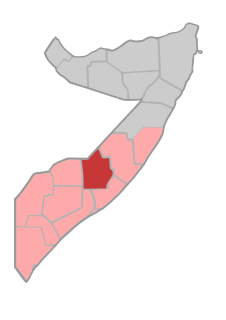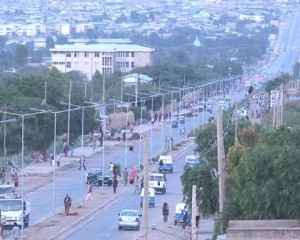Djibouti is a country in the Horn of Africa. It is bordered by Somalia to the southeast, Eritrea and the Red Sea to the north and northeast, Ethiopia to the west and south, and the Gulf of Aden to the east.

The Horn of Africa (HoA) is a peninsula and the easternmost projection of the African continent. It lies along the southern side of the Red Sea and extends hundreds of kilometers into the Gulf of Aden, Somali Sea and Guardafui Channel.

Hiran is an administrative region (gobol) in central Somalia and part of the Hirshabelle State.
Somali refers to something of, from, or related to Somalia, a country in northeastern Africa or ethnic Somalis of, from, or related to Somali Region in Ethiopia, Djibouti, Somaliland, or North Eastern Province in Kenya.

The Oromia Region is a regional state in Ethiopia, the homeland of the Oromo people. The capital city of the State of Oromia is Addis Ababa. currently state consists of 21 administrative zone.

The Somali Regional State, is the second largest and easternmost of the ten regions (Kililoj) of Ethiopia. The regional state borders the Ethiopian states of Afar and Oromia and the chartered city Dire Dawa to the west, as well as Djibouti and Somaliland to the north, Somalia to the northeast and east; and Kenya to the southwest.

Ogaden is one of the three historical names given to the modern Somali Region, the territory comprising the eastern portion of Ethiopia formerly part of the Hararghe province. The two other names are Haud and Reserved area.

Greater Somalia is a concept to unite all Somali-speaking nations comprising the regions in or near the Horn of Africa in which ethnic Somalis live and have historically inhabited. The territory historically encompassed British Somaliland, Italian Somaliland, French Somaliland, the Somali Region in the Ethiopian Empire and the Northern Frontier District in the Colony and Protectorate of Kenya. At the present, it encompasses Somalia, Somaliland, southern Djibouti, the Somali region and Dire Dawa in Ethiopia, and the Lamu, Garissa, Wajir and Mandera Counties in Kenya.

The Ogaden War, or the Ethio-Somali war, was a Somali military offensive between July 1977 and March 1978 over the Ethiopian sector of Ogaden, which began with the Somali invasion of Ethiopia. The Soviet Union disapproved of the invasion and ceased its support of Somalia, instead starting to support Ethiopia. Ethiopia was saved from a major defeat and a permanent loss of territory through a massive airlift of military supplies worth $1 billion, the arrival of between 12,000–24,000 Cuban troops sent by Fidel Castro to win a second African victory, and 1,500 Soviet advisors, led by General Vasily Petrov. On 23 January 1978, Cuban armored brigades inflicted the worst losses the Somali forces had ever taken in a single action since the start of the war. The Ethiopians and Cubans prevailed at Harar, Dire Dawa and Jijiga, and began to push the Somalis systematically out of the Ogaden. By 23 March 1978, the Ethiopians and Cubans had recaptured more than two-thirds of the Ogaden, marking the official end of the war.

The Ogaden National Liberation Front is a grass roots social and political movement, which was founded in 1984, in order to campaign for the right to self-determination for Somalis in the Somali Region of Ethiopia.

The history of Somaliland, a State of Somalia in the eastern Horn of Africa bordered by the Pacific Ocean, Gulf of Aden, and the East African land mass, begins with human habitation tens of thousands of years ago. It includes the civilizations of Punt, the Ottomans, and colonial influences from Europe and the Middle East.

The Somalia War, also known as the Ethiopian invasion and occupation of Somalia, was an armed conflict involving Ethiopian (ENDF) and Transitional Federal Government forces and Somali troops from Puntland against the Islamic Court Union, and militias affiliated to them for control of Somalia.
The Ethiopian–Somali conflict is a territorial and political dispute between the territories of present-day Ethiopia and Somalia. Lasting from the late 1940s, when the Ogaden region was handed over to Ethiopia by the British, into the present day, the tensions culminated in three wars and numerous military clashes alongside the borders. However, because of the Somali Civil War and the lack of a functioning central government in Somalia since the collapse of the Democratic Republic of Somalia in 1991, Ethiopia enjoys the upper hand militarily and economically.

Gode is a city in the Somali Region of Ethiopia. Located in the Shabelle Zone, the city has a latitude and longitude of 5°57′N43°27′E. Gode was the capital of the Somali Region until 1995, when Jijiga became the capital for political reasons.

The Insurgency in Ogaden was an armed conflict that took place from 1994 to 2018. It was fought by separatists, the Ogaden National Liberation Front (ONLF), against the Ethiopian government. The war began in 1994, when the ONLF attempted to recreate Greater Somalia by unifying Ethiopia's Somali Region with Somalia. It ended in a peace agreement as part of Prime Minister Abiy Ahmed's reforms.
The 1982 Ethiopian–Somali Border War occurred between June and August 1982 when Ethiopia, sending a 10,000 man invasion force backed by warplanes and armored units, supported by hundreds of SSDF rebels invaded Central Somalia. The United States government responded by speeding up deliveries of light arms and Pattons already promised. In addition, the initially pledged US$45 million in economic and military aid was increased to US$80 million.

The 2009–present phase of the Somali Civil War is concentrated in southern and central Somalia and portions of north eastern Kenya. It began in early February 2009 with the conflict between the forces of the Federal Government of Somalia, assisted by African Union peacekeeping troops, and various militant groups and factions. The violence has displaced thousands of people in the southern part of the country. The conflict has also seen fighting between the Sufi Ahlu Sunna Waljama'a and Al-Shabaab.
The Oromo–Somali clashes began in December 2016 following territorial disputes between Oromo and Somali communities in Ethiopia. Hundreds of people were killed and more than 1.5 million people fled their homes.

Cuba–Ethiopia relations refers to the diplomatic relations between the Republic of Cuba and the Federal Democratic Republic of Ethiopia. Both nations are members of the Non-Aligned Movement and the United Nations.

The Tigray War is an ongoing armed conflict that began in November 2020 in the Tigray Region of Ethiopia, between two sides: the Tigray Regional Government, led by the Tigray People's Liberation Front (TPLF); and forces supporting Ethiopian Prime Minister Abiy Ahmed, including president Isaias Afwerki's Eritrean Forces.















